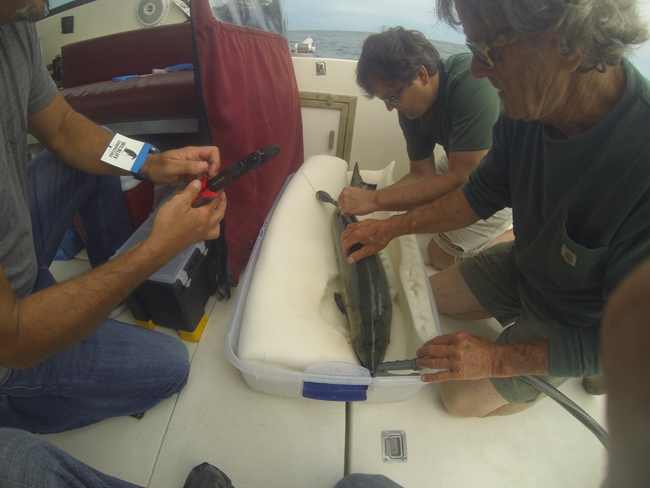
Investigator James Watkins (in green t-shirt) attaches a tag to a salmon offshore of Oswego, NY in mid-July 2017 with the assistance of charter boat captain Ernie Lantiegne and researcher Chris Perle (Florida State College). Credit: Chris Marshall
— By Chris Gonzales, Freelance Science Writer, New York Sea Grant
Ithaca, NY, April 19, 2020 – Imagine you could attach a camera to a salmon, then watch its migratory path across the Great Lakes. In fact, scientists have done something quite like it, except instead of using a camera they are using electronic sensors that send them signals by way of a satellite link.
These sensors, or “tags,” are attached to the fish. The “tagging” or remote sensing of wildlife is a technique used by a growing number of biologists and ecologists around the world to track animals such as tuna, swordfish, and sea turtles.(1)
Using these tags, a team of ecologists have collected months-long records of individual fish swimming in Lake Ontario from Oswego, New York to distant locations, such as the shores of Canada and several connecting streams and rivers.
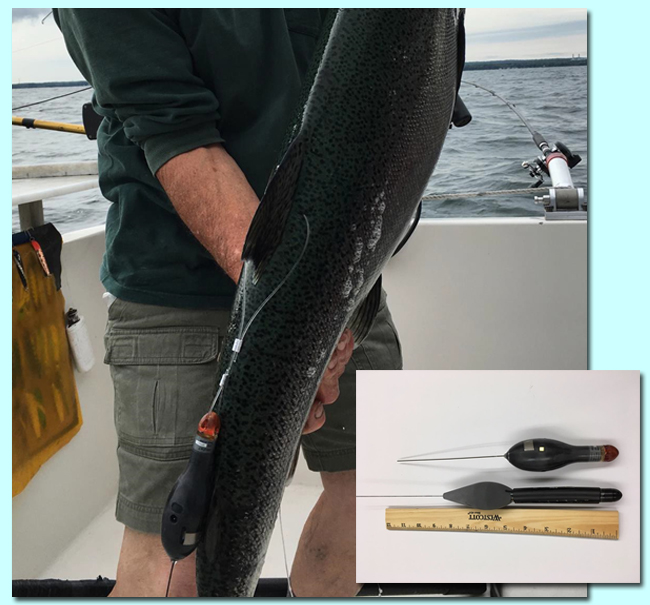
Ernie Lantiegne (Fish Doctor Charters) holds a mature Chinook Salmon in mid-July 2017 with a Wildlife Computer Mini-PAT tag attached that’s ready for return to Lake Ontario from just offshore Oswego, NY. The MiniPAT tag (also top in inset photo), which has a freshwater release (orange cap), was one of two types of pop-off satellite archival tags (PSATs) compared during the NYSG study. The other (bottom in inset photo) is a Desert Star tag, which releases uses a pyrotechnic (black powder) approach. During the study five of each type of tag were deployed in July-August 2017, with an additional 10 Mini-PATs in July- September 2018. Credit: Jim Watkins/Cornell University
“We have successfully tracked adult Chinook salmon from where we tagged them offshore of Oswego to large tributaries throughout the lake including the Niagara, Salmon, and Oswego Rivers as well as smaller streams such as Cobourg Creek,” said James Watkins, a senior research associate at Cornell University’s College of Agriculture and Life Sciences (CALS), Department of Natural Resources. Lars Rudsam, also from CALS, is co-PI on this New York Sea Grant-funded study.
The investigation comes at an interesting time for the dynamic fisheries industry in the Great Lakes, valued at $4-7 billion.(2)
“Salmon—though a nonnative predator—are undoubtedly an important economic driver for both offshore and river guides in small, coastal towns and even inland communities,” said Watkins.
How It’s Done
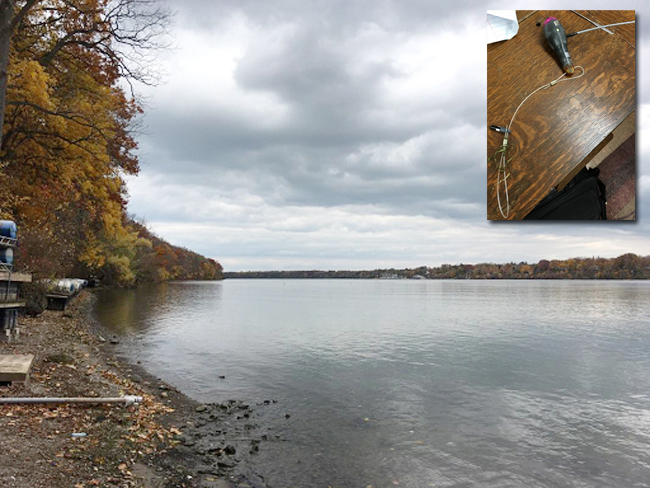
A tag (like in inset photo) was recovered in early November 2018 on the shores of the lower Niagara River (at Smuggler’s Cove Boat Club in Niagara-on-the-Lake, Ontario) after tagged fish spawned. Information collected via the tag was then downloaded to a computer. Credit: Jim Watkins/Cornell University
The tags collect data at a rate of up to once every second, and the data are quite rich—confirming information such as the depth of the fish, the temperature of the surrounding water, light level, and even the acceleration of the fish.
They tracked one fish, for example, that completed a 45-day journey from Oswego to a tributary known as a spawning site near Cobourg, Ontario, Canada—across the lake, and halfway to the west end.
“The resulting high-resolution data about temperature, light, depth, and movement have informed us of the dynamic daily behavior of the fish, including deep dives and shallow excursions from their typical habitat near the base of the thermocline,” continued Watkins.
It may sound like an adventure, but these data provide scientists, wildlife enthusiasts, anglers, and economists alike with details about the life cycle and behavior of these prized aquatic animals, yielding insights that not only are fascinating to ecologists; the research arguably is enhancing the experiences of angling visitors, a lifeforce for the region’s fishing and guide industries.
Surprising Clarity
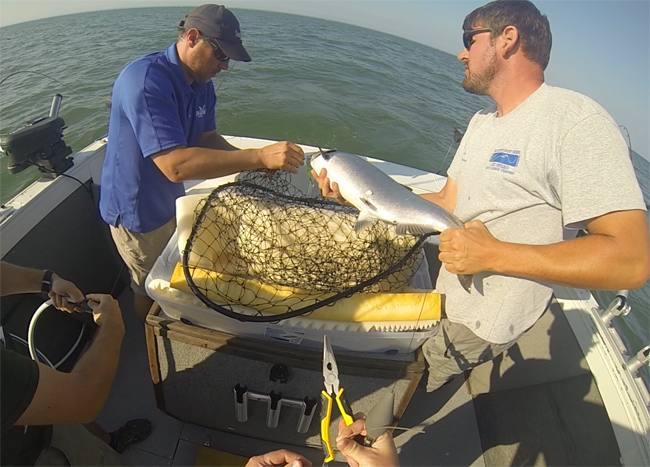
NYSG Fisheries Specialist Jesse Lepak (at left) prepares to attach a satellite tag in mid-July 2017 to a Lake Ontario king salmon offshore of Braddock’s Bay on a charter boat run by Rochester Sport Fishing’s Kip Mammone. This was part of research to assess the movement and behavior of this important fishery. Credit: Jim Watkins/Cornell University
The sensors aren’t capable of delivering information in real time, but rather after a certain amount of time, or under some conditions, when the tag is released from the animal. Then it hopefully finds its way back to the researchers.
Researchers figured out details such as the preferred water temperature for the salmon: about 55 degrees Fahrenheit, generally found at a depth of 50 feet. “Quite deep for an angler to target!” said Watkins.
“The depths [where we see salmon] may surprise bass anglers and people with experience fishing from shore or in shallow water,” added NYSG’s Fisheries Specialist Jesse Lepak, who is also working on the project. “Usually these fish swim in shallow water only when they come back to the streams to spawn.”
The research team noted several instances where the migrating fish left their comfort zone, sometimes diving to great depths, while at other times moving upward into warmer surface waters, likely in pursuit of their favorite little prey fish, the alewife.
One data record shows a fish diving to a depth of 328 feet below. That’s so deep that the water pressure felt by the fish is ten times greater than on the surface, where it was less than a minute before.(3)
Although scientists are still analyzing the data, their preliminary work shows that a salmon will make these dives during the day, in the span of minutes. The fish then will make a step-like, gradual return to its comfort zone. In contrast, most of the salmon’s forays into surface water occur at night.
Gains for Science—and Fishing
This research has remarkable implications for the study of the lake itself. Specifically, we can learn about spots of water of different temperatures and densities—a specialization known as hydrography. One scientist on the team imagines a fleet of live fish “gliders” collecting information about lake water characteristics.
Scientists believe they now have detailed enough data showing salmon rising into warm surface water, at no small expenditure of energy for the fish, at night, in pursuit of alewife as the little fishes’ “defensive huddles,” or schools, disperse for the evening.
Impacts and Effects
Researchers noted that they opened communication channels between scientists and charter boat captains, an important step for continued research and management efforts.
“Charter boat captains have helped us tag fish, and in turn we have informed them of the dynamic behavior the tags reveal,” said Watkins. “Increased knowledge of these fish may help us manage the important fishery as their forage have decreased.”
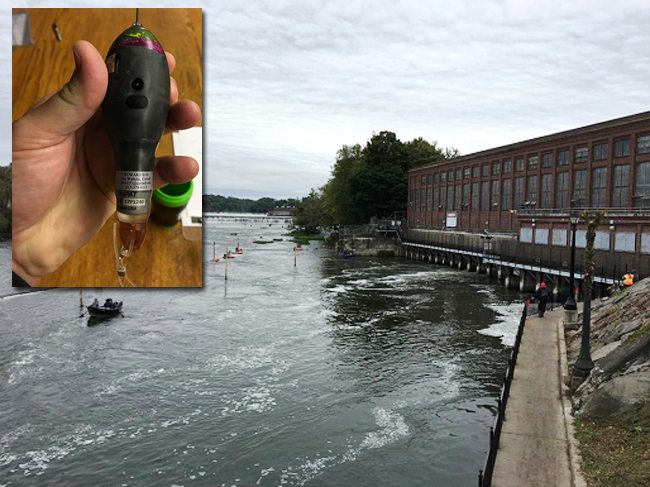
Two tags were recovered in early October 2018 from fish spawning at Varick Dam fishing area in Oswego, NY. The incentive for picking up a loose tag? The Mini-PAT tag (insert) includes return and $100 reward information. This information has led to five tag returns by tributary fishermen and beachcombers. Data can be downloaded directly to a computer using the port covered by the rubber plug near the thumb. Credit: Jim Watkins/Cornell University
With the detailed water temperature data they collected, ecologists now have an improved understanding of stressors for salmon related to climate change and prey shortage. The research also produced technical advances for using tags in freshwater, which typically have been used in saltwater, where the tag’s release mechanism operates more effectively.
“We also have relied on members of the public in finding these [tags] and returning them to us for a reward,” Watkins noted. “This has been a great way to interact with the public.”
These details have proven interesting for charter boat captains and their angling visitors to the region, adding to their overall experience.
Above all, though, the research provides new insights for science—and fishing and guide industries—well into the future.
Footnotes / References
(1) https://oceantracks.org/library/tags/pop-up-archival-satellite-tags Accessed November 26, 2019.
(2) https://www.michiganseagrant.org/topics/fisheries-and-aquaculture Accessed November 26, 2019.
(3) https://appmeas.co.uk/resources/pressure-measurement-notes/how-is-pressure-related-to-altitude-and-depth Accessed November 26, 2019.
More Info: New York Sea Grant
New York Sea Grant (NYSG), a cooperative program of Cornell University
and the State University of New York (SUNY), is one of 34 university-based
programs under the National Oceanic and Atmospheric Administration’s
National Sea Grant College Program.
Since 1971, NYSG has represented a statewide network of integrated
research, education and extension services promoting coastal community
economic vitality, environmental sustainability and citizen awareness
and understanding about the State’s marine and Great Lakes resources.
Through NYSG’s efforts, the combined talents of university scientists
and extension specialists help develop and transfer science-based
information to many coastal user groups—businesses and industries,
federal, state and local government decision-makers and agency managers,
educators, the media and the interested public.
The program maintains Great Lakes offices at Cornell University, SUNY
Buffalo, SUNY Oswego and the Wayne County Cooperative Extension office
in Newark. In the State's marine waters, NYSG has offices at Stony Brook
University in Long Island, Brooklyn College and Cornell Cooperative
Extension in NYC and Kingston in the Hudson Valley.
For updates on Sea Grant activities: www.nyseagrant.org has RSS, Facebook, Twitter, and YouTube links. NYSG offers a free e-list sign up via www.nyseagrant.org/nycoastlines for its flagship publication, NY Coastlines/Currents, which is published quarterly. Our program also produces an occasional e-newsletter,"NOAA Sea Grant's Social Media Review," via its blog, www.nyseagrant.org/blog.